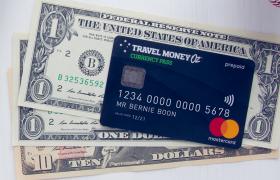Quick Contact

1st January 2019
We did it! We survived another year. 2018 brought 3 new babies to the Kardashian empire, 2 Australian Prime Ministers, around 7 tweets per day from President Trump and the great Bunnings sausage sizzle onion debate. 2018 also saw a multitude of events influencing the value of the Aussie dollar - particularly Brexit, the movement of US interest rates and the US/China trade war.
If, like us, travel is at the top of your New Year's resolutions, you’re probably wondering what 2019 has in store for the AUD and, in turn, your travel money. Honestly, same. We’re in the business of travel money and would love to know how the Aussie Dollar is going to perform.
Truth is, no one really knows. However, we’ve had a look at a few reports and predictions before compiling the most pertinent parts here. We can’t guarantee any of these predictions will come to fruition. Despite this, we always recommend educating yourself as much as possible when it comes to foreign exchange, that way you can be as prepared as possible for market movements. In other words, more knowledge often leads to more travel money in your back pocket.
So, without further ado, let’s get started. I know you’re probably nursing some sort of ailment after one too many last night, so I promise to keep this short and sweet.
Too busy celebrating 2019 to think about foreign currency? Sign up for rate alerts and we’ll do the hard work for you.
First things first - a round of applause for our currency.
The AUD is often referred to as the ‘Aussie battler’ and for good reason. The Aussie dollar is a pretty special currency (and not just because our mum says so). Despite being the 13th largest economy in the world, our currency is around the fifth most traded on global markets. We do a lot of international trade, and our time zone means traders in Sydney are awake when markets in Europe and North America are asleep.
The AUD is a pretty risky currency, and the value is more likely to increase during ‘risk-on’ market sentiment. So, if there is low risk in the market investors will engage in higher-risk investments like the Aussie dollar. In other words, if Trump’s 7 tweets are about something a bit crazy, and China seems to be all over the shop, it’s less likely the AUD will be performing well.
We get it, you love the Aussie Dollar. What is on the cards for 2019?
I’ll try and keep it snappy because time is precious and you have a new year to celebrate (and hopefully a holiday to plan).
As of December 24, markets are pricing a 56 percent probability that US interest rates will remain at the current level of 2.25-2.5 percent in January 2020, with only a 25 chance that it will be moved higher.
In contrast, the Federal Open Market Committee (FOMC) held their last meeting for 2018 on December 18-19 and signalled that there will likely be two more rate hikes in 2019 and another in 2020. In other words, the market seems to believe we have reached the end of interest rate hikes for the time being, despite what the Fed says.
What does this mean for Australia and Aussie travellers? Well, as US interest rates increase relative to those in Australia, it means investors can get more bang for their buck in the States compared to here in Australia. Less demand for the AUD could push down it’s value, especially against the USD.
Australian interest rates are expected to remain on hold with markets suspecting Aussie economic growth will slow in 2019 under the weight of political uncertainty (aka a Federal election and probably a new Prime Minister), decreasing house prices, a softening labour market and global volatility. If the US increases their interest rates while we keep ours on hold, there will be downward pressure on the value of the AUD.
If Chinese economic growth slows down more than expected, as a result of softening anti-pollution policies, it could decrease the demand for imported Australian commodities. Lower demand for our commodities generally means less demand for the AUD and a potential decrease in value.
It looks like the Chinese / US trade war will continue to play out into 2019. On December 1 President Trump and President Xi Jinping agreed to a 90 day ceasefire while both respective parties work to ease the tensions and reach a mutually beneficial deal. Should they not reach an agreement, there is the potential that Trump will impose a 25% tax on $250billion worth of Chinese imports into the US. This would be bad for the AUD, as our economy is intrinsically linked with China due to our strong trade ties.
Should these trade tensions come to an end as a result of a bonza deal between the two countries, we could see a boost to market sentiment,positive impact on Chinese growth expectations and a ‘risk-on’ attitude (as mentioned above) which could be favourable for the AUD.
Brexit will have a major impact on the value of the AUD relative to the Great British Pound in 2019. The UK is set to leave the EU in March. Currently nobody really knows what’s up or down when it comes to Brexit negotiations. At this stage it is highly likely that the UK will leave with no divorce agreement in place which would be, quite frankly, a huge shamozzle. If we’re being honest though, Brexit is a good news story for the AUD (or at least Aussie travellers heading to the UK)… As Britain rides the Brexit wave, it is likely that the resulting market volatility will push the value of GBP down against the Aussie Dollar. We’ve done a more in depth breakdown of Brexit and its effect on Aussie travellers, so I’ll save you the details for now.
What about the value of the AUD in 2019?
The banks have released some forecasts for what they expect the value of the AUD to be against the USD by the close of 2019.
ANZ and NAB are putting a dampener on our New Year’s mood, with a forecast of 0.70. However, Both NAB and CBA are slightly more optimistic, expecting the AUD to gradually increase towards 0.75.
As you can see, no one really knows what will happen with markets and the AUD in 2019. We can, however, guarantee a year full of market fluctuations as investors grapple with everything happening in our global economy.
With all of this in mind, we, at Travel Money Oz, recommend the following when it comes to purchasing your foreign currency in 2019.
- Stay up to date with news. It pays to be in the know with this kind of thing, as well as have an understanding of what is affecting the AUD.
- Sign up for currency alerts, that way we can let you know when your currency reaches your preferred rate.
- Add Rate Guard to your transaction in store. If the exchange rate improves within 14 days of purchase, we will refund you the difference*.
- Don’t leave purchasing your currency until the last minute, and please don’t wait to purchase at the airport.
- Take advantage of our Best Price Guarantee. If you find a better price from an Australian competitor we will beat it*.
- Join the Travel Money Club and be in the draw to win $500 every month (plus get heaps more tips and tricks straight to your inbox).
From everyone at Travel Money Oz, we wish you a 2019 full of amazing travel adventures, and even more amazing exchange rates.
This blog is provided for information only and does not take into consideration your objectives, financial situation or needs. You should consider whether the information and suggestions contained in any blog entry are appropriate for you, having regard to your own objectives, financial situation and needs. While we take reasonable care in providing the blog, we give no warranties or representations that it is complete or accurate, or is appropriate for you. We are not liable for any loss caused, whether due to negligence or otherwise, arising from use of, or reliance on, the information and/or suggestions contained in this blog. All rates quoted are market rate, which may not be available to the general public. *Terms and conditions apply to Rate Guard, Best Price Guarantee and the Travel Money Club. See travelmoneyoz.com for more details.












